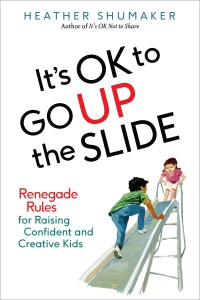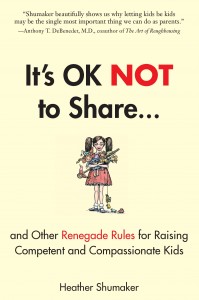A World of Books and Children
Search and enjoy 8 years of posts chock-filled with ideas from It’s OK Not to Share and beyond.

Introducing...one of the characters from my soon-to-be-published children's book.
I have AMAZING news!
All my life I've wanted to write fiction, especially fiction for children. I can't think of a time when I didn't want to write books. My desire to become an author was strong by age four.
Now I'm thrilled to announce that my first children's novel will be published by Simon & Schuster: The Griffins of Castle Cary.
So excited! The book is being described as a charming, slightly spooky adventure story for elementary readers ages 8-12. You'll meet the Griffin siblings, a couple of ghosts with big feelings, and a ginormous, drooly Newfoundland dog. My new editor says it's got "Penderwick-y appeal and Neil Gaiman themes," so if you like books with wholesome, family charm, like the Penderwicks or a touch of magic mixed in with real life, this might be the book for you and your family.
I like to think that preschoolers who started out with It's OK Not to Share in their lives will be ready for The Griffins of Castle Cary when it comes out. Only one year to wait - publication is March 2019. In the meantime, we'll be busy with revisions, copyedits and creating a cool cover. Maybe with a Newfoundland on the front?
Can't wait to show you the finished book!
Meanwhile, here's what some early readers had to say. These are all quotes from kids. As part of the book writing process, I had children read the draft manuscript.
Elizabeth, age 8: Keep going! Keep going! I was so excited. I wanted my mom to read more chapters before bed. There were so many mysteries.
Emerson, age 11: I've never read anything like this. I love all the action!
Tess, age 11: If there was a sequel, I would read it in a flash! It was really gripping. And just the right amount of scary. I finished it in two days and it was hard to put down when I had to go to bed.
Alex, age 9: It was awesome! Part mystery, part ghost story. I never wanted to stop reading it.
Thrilled to be a children's book author as well as a renegade. Looking forward to sharing more book adventures with you.
How cute is that Newfoundland dog? Will your kids or grandkids be the right age to enjoy this adventure next year?

Focus on children's real needs, not adult classroom habits.
When I walk into an early childhood classroom, I look for promising signs of play, like giant cardboard boxes, dress-ups clothes, and a bit of mess. What I often see are the Big Three: Behavior Charts, Calendars and Weather Charts. That's a sign of trouble.
These three charts have got to go.
Young children have so much learning to do. These three charts take up time and get in the way of meaningful social/emotional and cognitive development. Calendars, weather charts and behavior charts may be popular classroom habits, but popular doesn't make them right.
Let's take a look at each one:
The Calendar
Teaching calendar time steals time. Time kids could be doing other things that are more developmentally appropriate. Experts who study human notions of time say calendar study has no meaning for children younger than first grade, and that holds true for many kids even at ages 7, 8 or beyond (see more in It's OK to Go Up the Slide). Their brains simply aren't ready. If you're hoping to introduce counting or other math and sequencing ideas, do it through songs (Five little monkeys) and play itself. Take the giant calendar off the wall.
The Weather Chart
Weather is only relevant to children when they are outside in it. So recycle that weather chart with its clouds and suns, and GO OUTSIDE. Kids will notice it's raining if they get wet. They might also notice some worms and puddles. Kids don't sit around chatting about the weather the way adults do - unless there's something cool to talk about, like a thunderstorm or a blizzard. Invest in a sturdy raincoat yourself, and don't bother about days that are drizzly. After all, a real rainbow is much more exciting than a picture of a rainbow.
Behavior Charts
These charts are creeping into classrooms at an astounding pace. From green-yellow-red stoplight charts, to rainbow colors, sad cloud faces, and more, these public behavior charts are on many preschool and elementary classroom walls. Way too many.
Children typically have a clip marked with their name, and the clip gets moved from the "good" category down, and possibly further down, during the course of the day. Offenses like wiggling, talking, being bored and being a young child get lumped in with legitimate behavior conflicts like hurting someone.
Understanding good social behavior - and DOING it - takes time to learn. The process isn't straightforward like a clip going down the chart. Human relationships and dealing with big feelings and conflicts is a messy, organic process. Kids can do it, but they need real-world practice and our guidance to learn emotional competence and conflict mediation skills. These skills are huge; they are the essence of any early childhood learning. Behavior charts use shaming, compliance without understanding, and threats (taking recess away). They do not teach skills. They do not change behavior overall. They do not teach children the real-life, essential skills they need to be successful. And too often, the reason kids are poking, talking and restless is that the adult-directed lesson is not a good match. Better go outside and play.
More blog posts
How to Find a True Play-based Preschool
Behavior Charts = Poor Adult Behavior
Books
It's OK Not to Share and It's OK to Go Up the Slide
What's on your walls? What would happen if you took these charts down? What would your ideal early childhood classroom look like?

Moral support, combined with confidence in our kids, is more powerful than a helicopter.
Surely, you're not one of those overly-supportive helicopter parents. Are you? For all of us, it bears examining from time to time.
What could your child be doing on her own, that you are doing for her?
This includes simple, physical tasks (pouring milk, packing lunch, cleaning the floor) to more complex social tasks (making phone calls (not texts), speaking up about a problem, trying something new).
The New York Times published an in-depth article this week about American teens and the sharp spike in social anxiety, fear of social discomfort and failure. It doesn't start with teens. How we guide children starts now.
My mother was a master of moral support. Moral support sounds simple and easy, but it can be tough on both sides. It means having the confidence and strength to stand there and say to your child: "I can be with you, but I won't do it for you."
"I can be with you, but I won't do it for you."
Those words have echoed in my mind my entire life. I can remember my mother saying them when I was 4 years old and having trouble cutting with scissors. When I was 5 and had a conflict with another child. At age 7 when I wanted a book at the library and needed to ask the librarian for help. I heard them as a young teen when I was nervous about making phone calls. The implicit message was: It's hard, but you can do it. I'll be here for you.
Being there. Simply presenting yourself as a warm, supportive body who stands beside your child does wonders. It's more powerful than you think.
"I can go with you, but you need to say the words yourself."
The social challenges are probably the most tough. Practice on little conflicts that come up. When a child doesn't like something, practice giving moral support to teach your child to advocate for herself and speak up. It will be uncomfortable. And it won't be easy (until your child gets enough practice), but it's necessary. "Did you like what she did? No, then tell her. Say "stop splashing my face." I will go with you, but you need to say the words yourself."
Moral support is an art. It's a balance. Sometimes it means having a keen eye, and understanding what your child is actually capable of doing, then staying firm and placing your confidence in them. It can mean turning away.
Last year I took my youngest out in the neighborhood fundraising. I stood behind, but he was expected to do the talking. Despite practicing and being eager to do it, he sometimes got tongue-tied when a neighbor opened the door, saying nothing. "You need to do the talking," I reminded him. "I'm right here." Some days we had to turn away, but in a few days he'd be back, ready to try again.
Each child may need a different approach, but they all could use a strong, powerful adult beside them offering moral support during tough times. You've heard the phrase "Face your dragons." The emphasis should be on your. We can't face a child's dragons for her, but we can stand beside her, strong and tall, giving the child the moral support she needs to face her own dragons.
Did you grow up this way? Do you think your child needs more experience and practice dealing with discomfort in her life? How good are you at standing by? When do adults intervene most?


